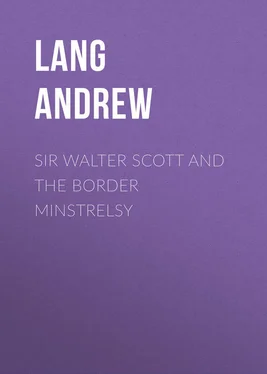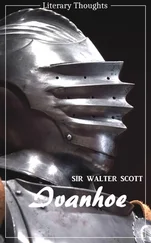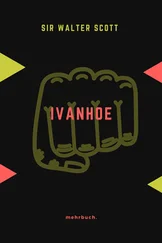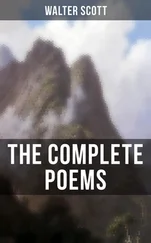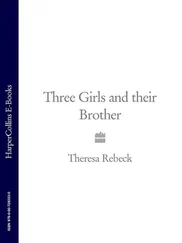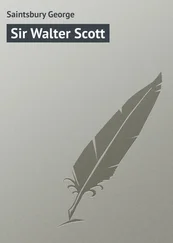Andrew Lang - Sir Walter Scott and the Border Minstrelsy
Здесь есть возможность читать онлайн «Andrew Lang - Sir Walter Scott and the Border Minstrelsy» — ознакомительный отрывок электронной книги совершенно бесплатно, а после прочтения отрывка купить полную версию. В некоторых случаях можно слушать аудио, скачать через торрент в формате fb2 и присутствует краткое содержание. Жанр: foreign_antique, foreign_prose, на английском языке. Описание произведения, (предисловие) а так же отзывы посетителей доступны на портале библиотеки ЛибКат.
- Название:Sir Walter Scott and the Border Minstrelsy
- Автор:
- Жанр:
- Год:неизвестен
- ISBN:нет данных
- Рейтинг книги:5 / 5. Голосов: 1
-
Избранное:Добавить в избранное
- Отзывы:
-
Ваша оценка:
- 100
- 1
- 2
- 3
- 4
- 5
Sir Walter Scott and the Border Minstrelsy: краткое содержание, описание и аннотация
Предлагаем к чтению аннотацию, описание, краткое содержание или предисловие (зависит от того, что написал сам автор книги «Sir Walter Scott and the Border Minstrelsy»). Если вы не нашли необходимую информацию о книге — напишите в комментариях, мы постараемся отыскать её.
Sir Walter Scott and the Border Minstrelsy — читать онлайн ознакомительный отрывок
Ниже представлен текст книги, разбитый по страницам. Система сохранения места последней прочитанной страницы, позволяет с удобством читать онлайн бесплатно книгу «Sir Walter Scott and the Border Minstrelsy», без необходимости каждый раз заново искать на чём Вы остановились. Поставьте закладку, и сможете в любой момент перейти на страницу, на которой закончили чтение.
Интервал:
Закладка:
Sir Walter’s method of editing, of presenting his traditional materials, was literary, and, usually, not scientific. A modern collector would publish things – legends, ballads, or folk-tales – exactly as he found them in old broadsides, or in MS. copies, or received them from oral recitation. He would give the names and residences and circumstances of the reciters or narrators (Herd, in 1776, gave no such information). He would fill up no gaps with his own inventions, would add no stanzas of his own, and the circulation of his work would arrive at some two or three hundred copies given away!
As Lockhart says, “Scott’s diligent zeal had put him in possession of a variety of copies in various stages of preservation, and to the task of selecting a standard text among such a diversity of materials he brought a knowledge of old manners and phraseology, and a manly simplicity of taste, such as had never before been united in the person of a poetical antiquary.”
Lockhart speaks of “The editor’s conscientious fidelity.. which prevented the introduction of anything new, and his pure taste in the balancing of discordant recitations.” He had already written that “Scott had, I firmly believe, interpolated hardly a line or even an epithet of his own.” 6 6 Lockhart, vol. ii. pp. 130–135 (1839).
It is clear that Lockhart had not compared the texts in The Minstrelsy with the mass of manuscript materials which are still at Abbotsford. These, copied by the accurate Mr. Macmath, have been published in the monumental collection of English and Scottish Popular Ballads , in ten parts, by the late Professor Child of Harvard, the greatest of scholars in ballad-lore. From his book we often know exactly what kinds of copies of ballads Scott possessed, and what alterations he made in his copies. The Ballad of Otterburne is especially instructive, as we shall see later. But of the most famous of Border historical ballads, Kinmont Willie , and its companion, Jamie Telfer of the Fair Dodhead , Scott has left no original manuscript texts. Now into each of these ballads Scott has written (if internal evidence be worth anything) verses of his own; stanzas unmistakably marked by his own spirit, energy, sense of romance, and, occasionally, by a somewhat inflated rhetoric. On this point doubt is not easy. When he met the names of his chief, Buccleuch, and of his favourite ancestor, Wat of Warden, Scott did, in two cases, for those heroes what, by his own confession, he did for anecdotes that came in his way – he decked them out “with a cocked hat and a sword.”
Sir Walter knew perfectly well that he was not “playing the game” in a truly scientific spirit. He explains his ideas in his “Essay on Popular Poetry” as late as 1830. He mentions Joseph Ritson’s “extreme attachment to the severity of truth,” and his attacks on Bishop Percy’s purely literary treatment of the materials of his Reliques of Ancient Poetry (1765).
As Scott says, “by Percy words were altered, phrases improved, and whole verses were inserted or omitted at pleasure.” Percy “accommodated” the ballads “with such emendations as might recommend them to the modern taste.” Ritson cried “forgery,” but Percy, says Scott, had to win a hearing from his age, and confessed (in general terms) to his additions and decorations.
Scott then speaks reprovingly of Pinkerton’s wholesale fabrication of entire ballads (1783), a crime acknowledged later by the culprit (1786). Scott applauds Ritson’s accuracy, but regrets his preference of the worst to the better readings, as if their inferiority was a security for their being genuine. Scott preferred the best, the most poetical readings.
In 1830, Scott also wrote an essay on “Imitations of the Ancient Ballads,” and spoke very leniently of imitations passed off as authentic. “There is no small degree of cant in the violent invectives with which impostors of this nature have been assailed.” As to Hardyknute , the favourite poem of his infancy, “the first that I ever learned and the last that I shall forget,” he says, “the public is surely more enriched by the contribution than injured by the deception.” Besides, he says, the deception almost never deceives.
His method in The Minstrelsy , he writes, was “to imitate the plan and style of Bishop Percy, observing only more strict fidelity concerning my originals.” That is to say, he avowedly made up texts out of a variety of copies, when he had more copies than one. This is frequently acknowledged by Scott; what he does not acknowledge is his own occasional interpolation of stanzas. A good example is The Gay Gosshawk . He had a MS. of his own “of some antiquity,” a MS. of Mrs. Brown, a famous reciter and collector of the eighteenth century; and the Abbotsford MSS. show isolated stanzas from Hogg, and a copy from Will Laidlaw. Mr. T. F. Henderson’s notes 7 7 Minstrelsy , iii. 186–198.
display the methods of selection, combination, emendation, and possible interpolation.
By these methods Scott composed “a standard text,” now the classical text, of the ballads which he published. Ballad lovers, who are not specialists, go to The Minstrelsy for their favourite fare, and for historical elucidation and anecdote.
Scott often mentions his sources of all kinds, such as MSS. of Herd and Mrs. Brown; “an old person”; “an old woman at Kirkhill, West Lothian”; “an ostler at Carlisle”; Allan Ramsay’s Tea-Table Miscellany ; Surtees of Mainsforth (these ballads are by Surtees himself: Scott never suspected him); Caw’s Hawick Museum (1774); Ritson’s copies, others from Leyden; the Glenriddell MSS. (collected by the friend of Burns); on several occasions copies from recitations procured by James Hogg or Will Laidlaw, and possibly or probably each of these men emended the copy he obtained; while Scott combined and emended all in his published text.
Sometimes Scott gives no source at all, and in these cases research finds variants in old broadsides, or elsewhere.
In thirteen cases he gives no source, or “from tradition,” which is the same thing; though “tradition in Ettrick Forest” may sometimes imply, once certainly does, the intermediary Hogg, or Will Laidlaw.
We now understand Scott’s methods as editor. They are not scientific; they are literary. We also acknowledge (on internal evidence) his interpolation of his own stanzas in Kinmont Willie and Jamie Telfer , where he exalts his chief and ancestor. We cannot do otherwise (as scholars) than regret and condemn Scott’s interpolations, never confessed. As lovers of poetry we acknowledge that, without Scott’s interpolation, we could have no more of Kinmont Willie than verses, “much mangled by reciters,” as Scott says, of a ballad perhaps no more poetical than Jock o’ the Side . Scott says that “some conjectural emendations have been absolutely necessary to render it intelligible.” As it is now very intelligible, to say “conjectural emendations” is a way of saying “interpolations.”
But while thus confessing Scott’s sins, I cannot believe that he, like Pinkerton, palmed off on the world any ballad or ballads of his own sole manufacture, or any ballad which he knew to be forged.
The truth is that Scott was easily deceived by a modern imitation, if he liked the poetry. Surtees hoaxed him not only with Barthram’s Dirge and Anthony Featherstonhaugh , but with a long prose excerpt from a non-existent manuscript about a phantom knight. Scott made the plot of Marmion hinge on this myth, in the encounter of Marmion with Wilfred as the phantasmal cavalier. He tells us that in The Flowers of the Forest “the manner of the ancient minstrels is so happily imitated, that it required the most positive evidence to convince the editor that the song was of modern date.” Really the author was Miss Jane Elliot (1747–1805), daughter of Sir Gilbert Elliot of Minto. Herd published a made-up copy in 1776. The tune, Scott says, is old, and he has heard an imperfect verse of the original ballad —
Читать дальшеИнтервал:
Закладка:
Похожие книги на «Sir Walter Scott and the Border Minstrelsy»
Представляем Вашему вниманию похожие книги на «Sir Walter Scott and the Border Minstrelsy» списком для выбора. Мы отобрали схожую по названию и смыслу литературу в надежде предоставить читателям больше вариантов отыскать новые, интересные, ещё непрочитанные произведения.
Обсуждение, отзывы о книге «Sir Walter Scott and the Border Minstrelsy» и просто собственные мнения читателей. Оставьте ваши комментарии, напишите, что Вы думаете о произведении, его смысле или главных героях. Укажите что конкретно понравилось, а что нет, и почему Вы так считаете.
